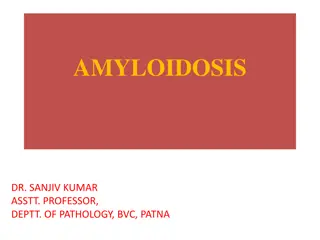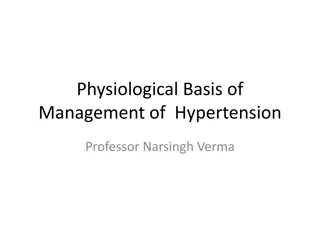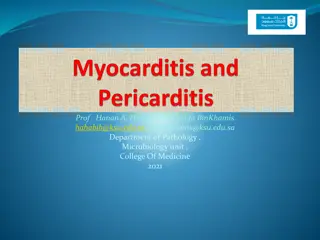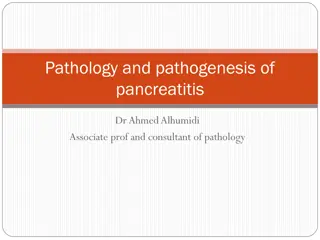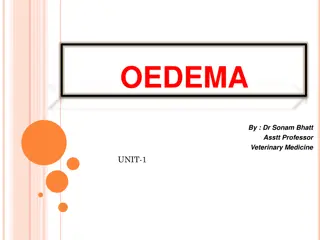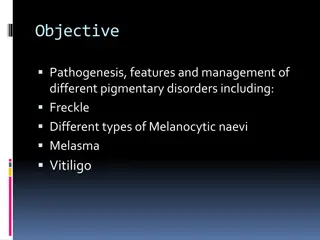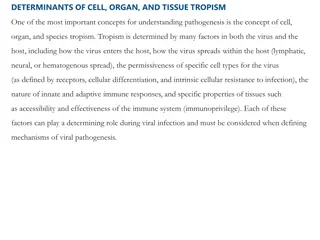Understanding Oedema: Causes, Types, and Pathogenesis
Oedema is an abnormal accumulation of fluid in body tissues that can lead to various health conditions. This article explores the definition of oedema, its different types (localized and generalized), and the pathogenesis behind it, such as decreased plasma oncotic pressure and increased capillary hydrostatic pressure. Understanding the underlying causes of oedema is essential for effective management and treatment strategies.
Download Presentation

Please find below an Image/Link to download the presentation.
The content on the website is provided AS IS for your information and personal use only. It may not be sold, licensed, or shared on other websites without obtaining consent from the author. Download presentation by click this link. If you encounter any issues during the download, it is possible that the publisher has removed the file from their server.
E N D
Presentation Transcript
Disturbances of the fluids (Lec. 2) Dr. Zainab Sajid Al-Shimmari
Oedema: may be defined as abnormal and excessive accumulation of free interstitial tissue spaces cavities. The presence collection of fluid within the cell is sometimes called intracellular oedema but should more be degeneration . fluid and of in the serous abnormal called hydropic
*Free fluid in body cavities: Depending upon the body cavity in which the fluid accumulates, it is correspondingly known as ascites (if in the peritoneal cavity), hydrothorax or pleural effusion (if cavity), and hydropericardium or pericardial effusion (if in the pericardial cavity). in the pleural
*Free The oedema fluid lies free in the interstitial space between the cells and can be displaced from one place to another. In the case of oedema in the subcutaneous tissues, pressure of finger produces a depression known as pitting oedema. fluid in interstitial space: momentary
The oedema may be of 2 main types: 1. Localized when limited to an organ or limb e.x. lymphatic oedema, inflammatory oedema, allergic oedema. 2. Generalized (anasarca or dropsy) when it is systemic in distribution, particularly noticeable in the subcutaneous tissues e.x. renal oedema, cardiac oedema, nutritional oedema.
PATHOGENESIS OF OEDEMA: 1- Decreased plasma oncotic pressure. (G.O.P.) The examples of oedema by this mechanism are seen in the following conditions: i) Oedema of renal disease e.x. in nephrotic syndrome, acute glomerulonephritis. ii) Ascites of liver disease e.x. in cirrhosis of the liver. iii) Oedema due to other causes hypoproteinaemia e.x. in protein-losing enteropathy. of
2. Increased capillary hydrostatic pressure. The examples of oedema by this mechanism are seen in the following disorders: i) Oedema of cardiac disease e.x. in congestive cardiac failure, constrictive pericarditis. ii) Ascites of liver disease e.x. in cirrhosis of the liver. iii) Passive congestion e.x. in mechanical obstruction due to thrombosis of veins of the lower legs, varicosities, pressure by pregnant uterus, tumours. iv) Postural oedema e.x. transient oedema of feet and ankles due to increased venous pressure seen in individuals who remain standing erect for longtime such as traffic constables.
3. Lymphatic obstruction. The examples of lymphoedema include the following: i) Removal of axillary lymph nodes in radical mastectomy for carcinoma of the breast produces lymphoedema of the affected arm. ii) Pressure from outside on the main abdominal or thoracic duct such as due to tumours, effusions in serous cavities may produce lymphoedema. iii) Inflammation of the lymphatics as seen in filariasis results in chronic lymphoedema of scrotum and legs known as elephantiasis. iv) Occlusion of lymphatic channels by malignant cells may result in lymphoedema
4. Tissue factors (increased oncotic pressure of interstitial). i) Elevation of oncotic pressure of interstitial fluid as occurs due to increased vascular permeability and inadequate removal of proteins by lymphatics. ii) Lowered tissue tension as seen in loose subcutaneous tissue of eyelids and external genitalia.
5. The examples of oedema due to increased vascular permeability are seen in the following conditions: i) Generalized oedema occurring in systemic infections, poisonings, certain drugs and chemicals, anaphylactic reactions and anoxia. ii) Localized oedema.Afew examples are as under: a)Inflammatory oedema as seen in infections, allergic reactions, insect-bite, irritant drugs and chemicals. It is generally exudate in nature. b)Angioneurotic oedema is an acute attack of localized oedema occurring on the skin of face and trunk and may involve lips, larynx, pharynx and lungs. It is possibly neurogenic or allergic in origin. Increased capillary permeability.
6. Sodium and water retention. i) Reduced glomerular filtration rate in response to hypovolaemia. ii) Enhanced tubular reabsorption of sodium and consequently its decreased renal excretion. iii) Increased filtration factor(increased filtration of plasma from the glomerulus). iv) Decreased capillary hydrostatic pressure associated with increased renal vascular resistance.The examples of oedema by these mechanims are as under: A-Oedema of cardiac disease e.x. in congestive cardiac failure. B-Ascites of liver disease e.x. in cirrhosis of liver. C- Oedema of renal disease e.x. in nephrotic syndrome, acute glomerulonephritis.
*DISTURBANCES IN THE VOLUME OF CIRCULATING BLOOD: HYPERAEMIA AND CONGESTION: 1-Hyperaemia and congestion are the terms used for localized increase in the volume of blood within dilated vessels of an 2-The increased volume from arterial and arteriolar dilatation being referred to as hyperaemia or active hyperaemia, whereas the impaired venous drainage is called venous congestion or passive hyperaemia. 3-If the condition develops rapidly it is called acute, while more prolonged and gradual response is known as chronic. organ or tissue;
Active Hyperaemia 1-The dilatation of arteries, arterioles and capillaries is effected either through sympathetic neurogenic mechanism or via the release of vasoactive substances. 2-The affected tissue or organ is pink or red in appearance (erythema). The examples of active hyperaemia are seen in the following conditions: i)Inflammation e.x. congested vessels in the walls of alveoli in pneumonia. ii)Blushing ,flushing of the skin of face in response to emotions. iii)Menopausal flush. iv)Muscular exercise, High grade fever, Goitr, Arteriovenous malformations. Clinically, hyperaemia is characterized by redness and raised temperature in the affected part.
Passive Hyperaemia (Venous Congestion): 1-The dilatation of veins and capillaries due to impaired venous drainage results in passive hyperaemia or venous congestion, commonly referred to as congestion. 2-Congestion may be acute or chronic, the latter being more common and called chronic venous congestion (CVC). 3-The affected tissue or organ is bluish in color due to accumulation of venous blood (cyanosis).
Types of venous congestion: 1-Local venous congestion results from obstruction to the venous outflow from an organ or part of the body e.x. portal venous obstruction in cirrhosis of the liver, outside pressure on the vessel wall as occurs in tight bandage, plasters, tumours, pregnancy, hernia, or intraluminal occlusion by thrombosis. 2-Systemic (General) venous congestion is engorgement of systemic veins e.x. in left-sided and right- sided heart failure and diseases of the lungs which interfere with pulmonary blood flow emphysema. like pulmonary fibrosis,
CVC Lung: Chronic venous congestion of the lung occurs in left heart failure , especially in rheumatic mitral stenosis so that there is consequent rise in pulmonary venouspressure. Grossly: 1- The lungs are heavy and firm in consistency. 2-The sectioned 3- The sectioned surface is rusty brown in colour referred to as brown induration of the lungs. . surface is dark.
Histologically: 1-The alveolar septa are widened due to the presence of interstitial oedema as well as due to dilated and congested capillaries 2-The septa are mildly thickened due to slight increase in fibrous connective tissue. 3-Rupture of dilated and congested capillaries may result in minute intra-alveolar haemorrhages. 4- The breakdown of erythrocytes liberates haemosiderin pigment which is taken up by alveolar macrophages, so called heart failure cells, seen in 5- The brown induration observed on the cut surface of the lungs is due to the pigmentation and fibrosis . the alveolar lumina.
CVC Liver Chronic venous congestion of the liver occurs in right heart failure and sometimes due to occlusion of inferior vena cava and hepatic vein. Grossly 1-the liver is enlarged and tender and the capsule is tense. 2-Cut surface nutmeg*appearance due to red and yellow mottled appearance, corresponding to congested center of lobules and fatty peripheral zone respectively . shows characteristic
Microscopically 1- The changes of congestion are more marked in the centrilobular zone due to severe hypoxia than in the peripheral zone. 2-The central veins as well as the adjacent sinusoids are distended and filled with blood. 3-The centrilobular hepatocytes undergo degenerative changes, and eventually centrilobular haemorrhagic necrosis may be seen. 4-Long-standing cases may show fine centrilobular fibrosis and regeneration of hepatocytes,resulting in cardiac cirrhosis . 5-The peripheral zone of the lobule is less severely affected by chronic hypoxia and shows some fatty change in the hepatocytes.
CVC Spleen Chronic venous congestion of the spleen occurs in right heart failure and in portal hypertension from cirrhosis of liver. Grossly: i)The spleen in early stage is slightly to moderately enlarged (up to 250 g as compared to normal 150 g), while in long-standing cases there is progressive enlargement and may weigh up to 500 to 1000 g. ii)The organ is deeply congested, tense and cyanotic.
Microscopically: i) Red pulp is enlarged due to congestion and marked sinusoidal dilatation and here are areas of recent and old haemorrhages. ii) There is hyperplasia of reticuloendothelial cells in the red pulp of the spleen (splenic macrophages). iii) There is fibrous thickening of the capsule and of the trabeculae. iv) Some of haemorrhages overlying fibrous tissue get deposits of haemosiderin pigment and calcium salts. v) Firmness of the spleen in advanced stage is seen more commonly in hepatic cirrhosis (congestive splenomegaly).
CVC Kidney Grossly: the kidneys are slightly enlarged and the medulla is congested. Microscopically: 1-The changes are mild and the tubules may show degenerative changes like cloudy swelling and fatty change. 2-The glomeruli may show mesangial proliferation.






